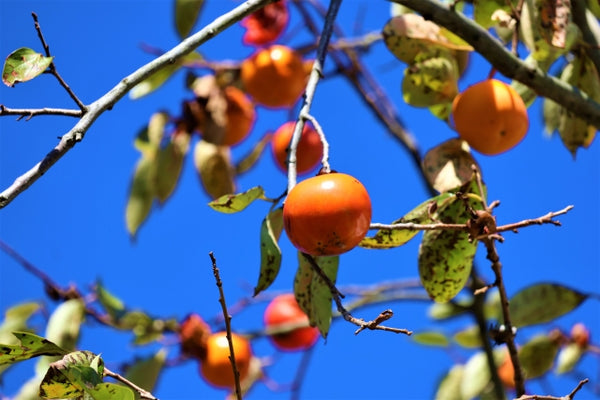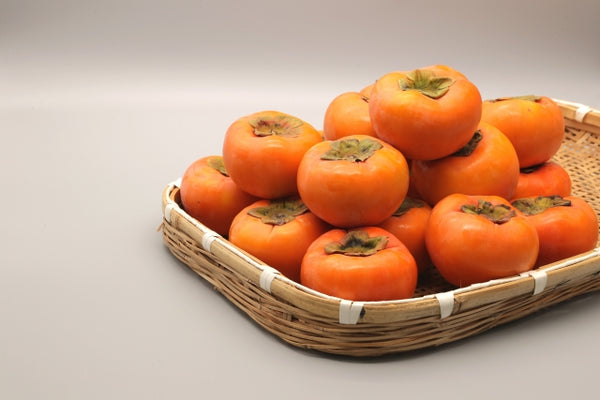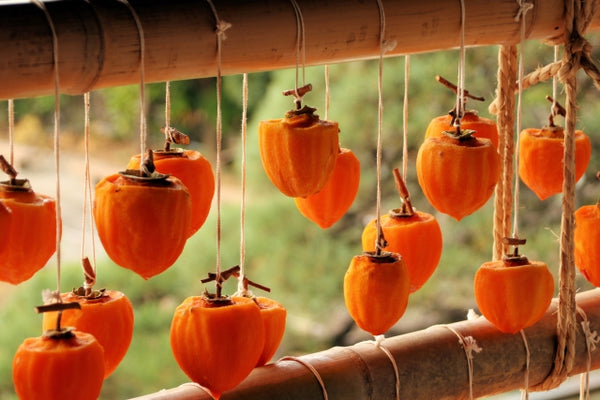Fuyu vs. Hachiya Persimmons

While many Americans may not be as familiar with this orange, tomato-like fruit, the persimmon, or kaki, is one of Japan’s favorite seasonal fall treats.
Returning to supermarkets as early as September, persimmon season typically runs from October to late December, with the majority of the fruit harvested in October or November. Around this time, persimmon-flavored treats will also pop up all around Japan, from savory foods to sweets.
Fresh persimmons are beloved by many, but persimmons can also be dried and turned into hoshigaki. Hoshigaki can take a month to age and dry outdoors, where they are exposed to both sun and the fall breeze before transforming into one of Japan’s most iconic autumn treats.
While persimmon consumption has decreased somewhat over the years, there has been an increase in the production of vacuum-packed persimmon to preserve the seasonal treat further into the year, even sticking around as late as March!
Not all persimmons are alike, however. Just like with applies, there are a wide variety of types of persimmons ranging in size, shape, color, and sweetness. Just west of Tokyo and North-East of Kyoto, Gifu prefecture is renowned for its persimmon production and special local varieties. In fact, Gifu is home to what are arguably the two most popular persimmon varieties: Fuyu persimmons and Hachiya persimmons. Here are a few points that might guide you in the direction of the persimmon that best fits your taste.
Fuyu Persimmons

Kind of like a brand name, the Fuyu persimmon hails from Mizuho City in Gifu, and is known as the “King of Persimmons.” It actually makes up about 70-80% of Gifu’s persimmon production!
Known for their juicy sweetness and smooth, glossy skin, they’re usually eaten fresh; peeled and sometimes served in slices and eaten with toothpicks.
The Fuyu persimmon harvest season is particularly short and comparatively late, running from late November into December. It’s thought that the late fall chill is what brings out some of this varieties’ sweetness.Some are even harvested in mid-December, while other specially selected fruit are wrapped in a bag while maturing on the tree and are left to ripen for longer, deepening their sweet, juiciness.
Hachiya Persimmons

Only making up about 1% of all persimmons cultivated in Gifu, Hachiya persimmons were born in the town of Hachiya in Minokamo City.
They are larger and longer in shape than Fuyu persimmons and are thought to resemble the shape of a hanging bell. Hachiya persimmons are known for their deep orange color and for their strong bitter flavor.
It’s this very bitterness that makes them so well suited to being dried and turned into hoshigaki. When traveling around the countryside in fall and early winter, you might spot them strung up on ropes hanging from the eaves of farmhouses and homes, honing their sweetness to perfection!
While Hachiya may not be as popular as Fuyu, they have a 1,000-year history, with records showing they were given as gifts to the imperial court. To this day, they are still thought of as a delicacy, often presented as gifts in winter and fall.
Hopefully, this glimpse into this beloved Japanese fruit might inspire you to seek one out this fall. That is, if you can get your hands on one!
About the Author:
 Kevin Kilcoyne
Kevin Kilcoyne



